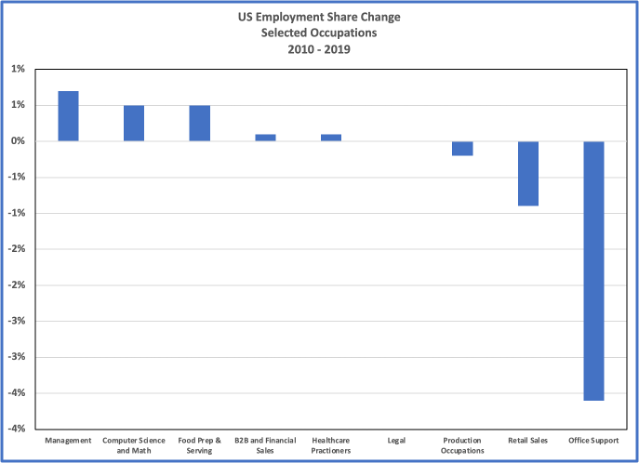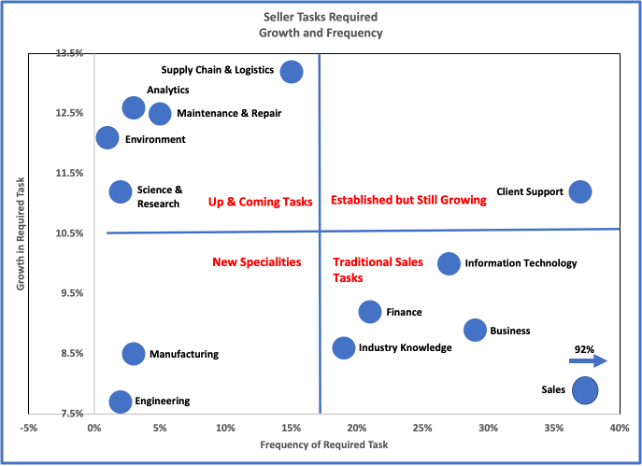It is no secret that work is changing, including the work of sellers. The COVID-19 pandemic has impacted all workers, profoundly disrupting how work is done, interrupting careers, and, in some cases, destroying income and wealth. Like all major social and economic transformations, for many workers, it won’t be possible to return to old ways. The world will look very different in the years and decades ahead. There will be a new normal.
However, for sellers, the world had already profoundly changed well before the emergence of the SARS-CoV-2 virus. The good news for those in the sales profession, outside the retail sector, selling roles remain in high demand. The challenge is employers need sellers to perform new tasks and, thus, sellers need to develop new skills.
Sellers maintain their significance in the US economy
As the US labor force has grown over the past decade, the sales profession has grown at the same pace. Sellers have maintained their importance, significance, and role. Excluding the retail sector, there were just more than 3.2 million sellers employed in 2010 and, by 2019 – the most recent year for which there is occupational data – there were nearly 3.9 million sellers in the US.
In both 2010 and 2019, B2B sellers, including the financial services sector, made up about 2.5% of the US labor force. The value and importance of the sales profession has been maintained even as US economy grew and expanded over the decade of the twenty-teens.
Figure 1, below, shows the change in employment share for selected US occupations over the past decade.
Figure 1

Source: US Department of Labor, Bureau of Labor Statistics with author’s calculations.
As might be expected, occupations such as office support, retail selling, and production have lost share, while the share of employment in healthcare, management and B2B selling has increased. Not surprisingly, the growth of e-commerce has resulted in reduced retail employment and increased transportation and inventory handling employment.
But, the role of sellers has changed
While B2B sellers have maintained their employment share, the nature of the selling role has changed with new tasks required. With the benefit of nearly 36 million job posts from Burning Glass Technologies, machine learning and natural language processing allows for a careful review of the job post text to learn how task requirements have changed and, thus, to identify new skill requirements.
Demand for sellers with analytical skills now dominates
Below, Figure 2 shows that analytics tasks are among those that have experienced the greatest increase in demand.
Figure 2

* Source: Burning Glass Technologies with author’s calculation
Depending on the sales role and the industry, analytics tasks can range from ad hoc reporting to data visualization to machine learning. With analytic-related task requirements in 3% of the job posts, these tasks, and the skills needed to deliver, are at the leading edge of future of work. It is also interesting that many sales roles now involve tasks in science and research, environment, as well as information technology.
Customer and sales related tasks also grow in importance
Beyond the analytical and quantitatively oriented tasks, the more expected customer and sales-related tasks have also increased in importance. Customer support, with a focus on advanced service, payment processing, and collection, has clearly taken on increased importance. Industry knowledge remains a critical focus area, as well.
Finally, while the requirement for a focus on basic sales tasks has experienced the smallest increase over the decade, not surprisingly, they are still the most sought-after tasks. More than 90% of job posts, and the sales roles they are trying to fill, expect those in sales roles to have basic sales skills.
In short, sales roles continue to grow, even as they change with the times
Occupations appear and disappear very infrequently. Data scientists are one of the few newly created occupations. It took years for elevator operators, as an occupation, to disappear, even with very few workers in the role. By contrast, sales roles continue grow in number and importance. However, sales roles are changing with new requirements expected. The transformation of selling is similar to the transformation impacting most occupations. All jobs will change. But the skill of all workers remains in high demand.
To learn how you can help your sellers be the best they can be, download this Sales Performance Management 101 guide.



